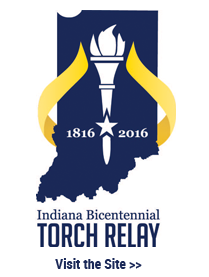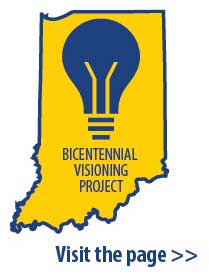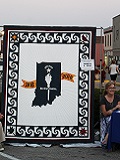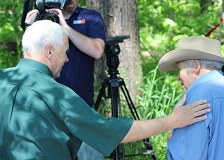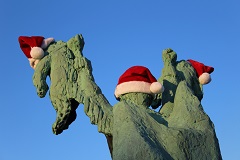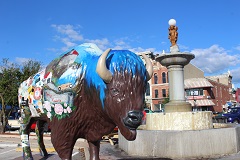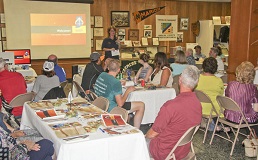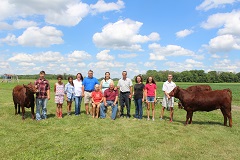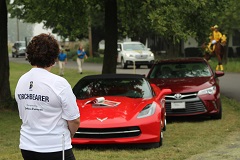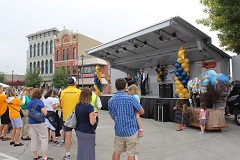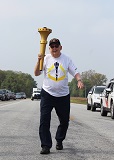- Business & Agriculture
- Residents
- Government
- Education
- Taxes & Finance
- Visiting & Playing
- Family & Health
Shelby County
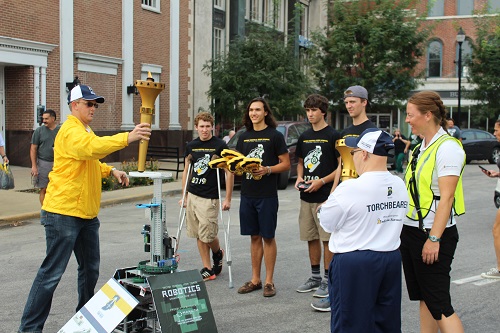
Q&A with County County Coordinator Rachael Ackley
What do you consider the key accomplishment(s) of your county’s Bicentennial celebration?
-
The establishment of the Meltzer Woods Bicentennial Nature Trust. The oldest standing forest has been preserved through a partnership of the Blue River Community Foundation, Shelby County Tourism and Visitors Bureau and the BNT and Central Indiana Land Trust. Meltzer Woods consists of 48 acres of old-growth forest. The woods have been included in Indiana’s Classified Forest Program since 1928 and were designated a National Natural Landmark in 1973.
-
Blue River Trails - another BNT partnership. Construction begins in March 2017 and will create a 4.2 mile nature walk/bike trail extending along Big and Little Blue Rivers, connecting two of our city parks.
-
The Shelbyville/Shelby County Pictorial History Book. A 128-page book of the history of Shelby County from its inception to 2016. A Shelby County book has not been done since 1997 - so this was perfect time to envelope in this project and preserve Shelby County history.
-
The Shelby County Reads Project. Highlighting Hoosier authors from children’s selections through adult reading. Hoosier authors were the highlight of the September First Friday events - and we had over 14 authors here for book signings. The First Friday festivities in September included all things Shelby County and Indiana history, including historical walks and building tours.
-
The Torch Relay - September 24, 2016. Not sure if I have ever seen so many tears and smiles in one event. Our 20 torchbearers were treated to a special dinner and training - where they received their uniforms and a bag full of surprises from Shelby County Tourism and Visitors’ Bureau. The day was topped off by the BBQ and BREWFEST - with an Indiana theme on Shelby County BBQ’ers and Indiana brewmasters.
-
Balsar - our Bison that was ornately painted and adorned by Shelby County High School artists. Shelby County Tourism funded this project, along with Shelby Couny United Fund for You - Shelby County’s proprietary “united way” organization. Balsar, named after the beloved character from Charles Major’s story The Bears of Blue River, was known to show up in the most interesting places from time to time. Bringing Bicentennial education and awareness.
What Legacy Project do you most like to tell people about, and why?
-
In November 2014, our historic Linden Tree fell to its demise. The story of the Linden Tree is one of historical significance laced with a bit of folklore. The Legend of the Linden Tree is a cherished story, handed down for generations in Shelby County.
It was told that the Miami Indian Chief, Mopiti, lived just south of the confluence of the Big Bear River (Big Blue) and the Little Bear River (Little Blue) in a village with his tribe, wife and seven children. Linden trees were abundant, and their wood was used for housing, building of canoes and for brewing as a tea. One day while the men were heading out for a hunt upstream in Passemong, the Miami village was plundered by a Delaware tribe, and all of the elders, women and children, including Mopiti’s seven sons and wife Kela, were killed. Upon their return, the men viewed the horror of those who had been slain, and an abrupt electrical storm began. Mopiti’s favorite tree, a large Linden tree, was struck by lightning, splitting it in two. The braves vowed revenge, and went in pursuit of the Delaware tribe - only to be ambushed. All of the Miami tribe were killed, except for Mopiti and two other braves; they survived.
Mopiti moved on and settled in a village near the Flat Rock River. Years later, Mopiti returned to his old home place. He found his favorite old Linden tree, fallen and rotting. Looking carefully at the base of the tree, Mopiti saw seven new shoots sprouting from the ground. He took this as a sign his seven sons' spirits were reincarnated into trees. Once a year, Mopiti would return to the tree to pay homage to the seven sons he lost.
Most of the tree was not in good condition - age had made many of its trunks rot and decay. However, we were able to save 10 large stump pieces, making them into tables, and enough dimensional lumber was saved for our state of Indiana pieces, along with turned candlesticks. We employed local woodsmith John Norris for the tasks of hand hewning the pieces. Plaques have been imbedded in the stumps - covered by glass-tops for protection. Due to the small amount of available Linden Tree mementos, these pieces have been given out to charitable organizations for use in auctions or to keep in their facilities.
Describe a highlight or most memorable moment related to your county's Bicentennial celebration.
-
As the county coordinator - I also spearhead the Torch Relay. I think when those who were nominated began receiving their letters - and began calling in to accept - these were some of the best conversations I have ever had with people. Many asking “why me? “What have I done to deserve this honor?”
I had nominated Connie Larkey on my own. A woman who has fought breast cancer not once, but twice. She turned her struggles in to a fundraising powerhouse with an event called “The Pink Out Game,” a yearly girls high school basketball game at Triton Central High School that has thus far garnered over $200,000 for the IWIN Foundation. IWIN, Indiana Women In Need, is a foundation that helps women who need financial and support assistance.
Connie has worked feverishly at creating an event that brings in donations from across Indiana for the silent auction, but most importantly, gives women who are currently fighting or have fought, an opportunity to shine during the survivors walk.
Max Bettner nominated his father, a WWII survivor who was at Normandy on that fateful day and for weeks afterward. Max said once his father knew he was nominated as a torchbearer, he began running laps daily around the manufacturing facility their family owns - preparing himself to run his portion of the relay. An 88 year old man determined he wasn’t walking his portion - he was going to run. And he did!
How/where are you preserving information and artifacts related to your county's celebration?
-
Shelby County is proudly preserving our Bicentennial items at the Shelby County Historical Society’s Grover Museum, and at the historic Porter Visitors’ Center.
-
Balsar - our Bicentennial Bison - will be on permanent display in front of the Porter Center. He will continue to welcome visitors and natives alike.
-
Our Bicentennial Quilt is on permanent display at the Grover Museum by the Bear Paw Quilters.
-
Our torch, a coin and medallion will be entombed in a display at the Grover Museum, along with a torchbearer shirt and jacket.
-
The Shelbyville/Shelby County Pictorial Book is on sale for anyone to purchase, but a copy is being retained with the historical society - as well as at the public library.
Total number of volunteers who participated.
- Total number of volunteers - including Torch Run volunteers: 87.
Estimated total attendance.
- At all endeavors - total of 23,550.
Estimated dollar amount spent (if applicable).
- $18,457.00.
Shelby County Legacy Projects
- Bicentennial Arbor Day Celebration
- Blue River Frontage– Bicentennial Nature Trust
- Indiana Bicentennial Quilt
- Meltzer’s Woods – Bicentennial Nature Trust
- Shelby County Remembers: A WWII Living History Experience
- Take Flight-Shelby County Calendar
Photos from Shelby County's Bicentennial Activities / Events
Please click the thumbnail to see a larger version of the image along with a brief description.
Shelby County Facts
Shelby County was named for Gen. Isaac Shelby, who defeated the British at the Battle of Kings Mountain in the Revolutionary War. Shelby then became the first governor of Kentucky. During the War of 1812, he led the army of Kentucky into Canada, and defeated the British at the decisive Battle of the Thames in 1813.

Shelby County’s Grover Museum has a gallery featuring a railroad diorama with running trains. Display cases show a wide range of signage, tools, and implements - everything associated with trains.
You can also leisurely stroll through time and history as you walk along the streets of Old Shelby circa 1900 as part of your museum visit.
Bears of Blue River
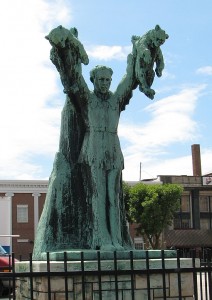 Charles Majors wrote The Bears of Blue River. In the popular book, he describes the adventures of a young boy growing up in early nineteenth-century rural Indiana on the Blue River.
Charles Majors wrote The Bears of Blue River. In the popular book, he describes the adventures of a young boy growing up in early nineteenth-century rural Indiana on the Blue River.
Thomas Hendricks, a Democrat from Shelbyville, Shelby County, served Indiana as a United States senator, a United States representative, governor, and as vice president under Grover Cleveland.
Indiana has been the home of 5 vice presidents and one president.
County Seat: Shelbyville
Year Organized: 1821
Square Miles: 411.15
Shelby County Bicentennial Committee
- Rachael Ackley - County Coordinator for Shelby County
- Margaret Newkirk
- Larry Lux
- Brian Asher
- Bill Rasner
- Carrie Ridgeway
- Elena Lisle
- Scott Newkirk
- Robin Fritz
- Al Taylor
- Mary Jo Phares
- Amy Glackman
- Cindy Reynolds
- Kathy Plunkett







